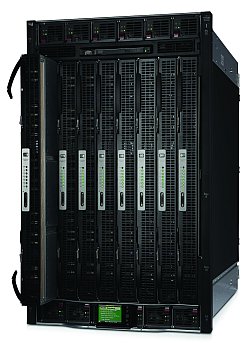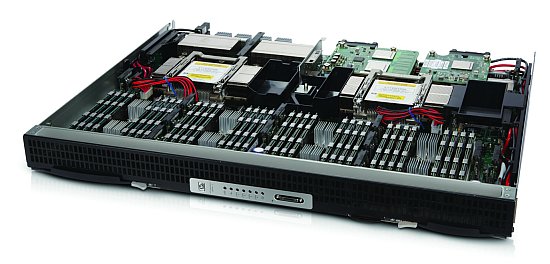Integrity Superdome Switches to Blade Architecture
 This September, HP celebrates the tenth anniversary of its flagship Unix-server HP Superdome, which was officially introduced on September 11, 2000. Over the years, several generations of this server have been released. The first Superdome, which was part of the HP 9000 RISC family of systems, used HP PA-RISC processors, and the next generation of the server, which appeared in 2003, supported both PA-RISC and Intel Itanium 2. And since 2007, HP completely Translated Integrity Superdome to Intel Itanium 9100 Dual Core Processors
This September, HP celebrates the tenth anniversary of its flagship Unix-server HP Superdome, which was officially introduced on September 11, 2000. Over the years, several generations of this server have been released. The first Superdome, which was part of the HP 9000 RISC family of systems, used HP PA-RISC processors, and the next generation of the server, which appeared in 2003, supported both PA-RISC and Intel Itanium 2. And since 2007, HP completely Translated Integrity Superdome to Intel Itanium 9100 Dual Core ProcessorsToday, the HP Integrity Superdome is a leader in the high-end server sector. For example, in our country since 2001, more than four hundred of these systems have been sold. They are used in large banks, telecommunications companies and government organizations as a hardware platform for mission-critical applications.
The anniversary of the first HP Superdome coincided with the biggest upgrade in ten years of the architecture of this server - in the fall, deliveries of the HP Integrity Superdome 2, built on the blade technology, began.
All previous generations of the HP Integrity Superdome consisted of four-socket motherboards (the so-called cell), connected via a crossbar switch to a multi-processor ccNUMA system. But now in Integrity Superdome 2, instead of the cells, double-socket blades with quad-core Itanium 9300 processors are used as server building blocks.
')

As a basis, the Integrity Superdome 2 developers took the HP BladeSystem c-Class best-selling blade design - the chassis of the new server (called enclosure) is very similar to the HP BladeSystem c7000 and uses a midplane interconnect panel, power supplies and fans from the c7000. However, this enclosure is higher by 8U, and therefore the Integrity Superdome 2 blades are longer than the classic blades installed in the HP BladeSystem c-Class. The increase in chassis size is primarily due to the appearance in the enclosure of the second midplane interconnect panel used to install the Crossbar Fabric switching modules needed to merge the server blades and connect multiple enclosure into one system. At the same time, increasing the size of the blades made it possible to place 32 DIMM slots for DDR3 memory modules on them (when using 8 GB modules, the maximum RAM size of one blade is a quarter of a terabyte).
 In addition, more power supplies fit into the enclosure chassis, so 2N power redundancy can be used in Integrity Superdome 2. Each blade also has “on board” two 10-port integrated 10 Gigabit Ethernet network adapters and three Mezzanine PCI-Express slots. To expand the I / O subsystem of the server, along with Superdome 2 enclosure, four-unit IOX I / O expansion modules can be installed in the rack, containing twelve PCI-Express slots (up to eight such units can be installed in one server).
In addition, more power supplies fit into the enclosure chassis, so 2N power redundancy can be used in Integrity Superdome 2. Each blade also has “on board” two 10-port integrated 10 Gigabit Ethernet network adapters and three Mezzanine PCI-Express slots. To expand the I / O subsystem of the server, along with Superdome 2 enclosure, four-unit IOX I / O expansion modules can be installed in the rack, containing twelve PCI-Express slots (up to eight such units can be installed in one server).The use of a universal blade form factor and the use of standard components made it possible to lower the price bar for the HP Integrity Superdome. The minimal model of the new Integrity Superdome 2 can be ordered in a single enclosure configuration with four blades and eight sockets. Unlike classic HP Integrity Superdome, which are housed in one or two special cabinets, the Integrity Superdome 2 chassis can be installed in a standard 19-inch rack along with other server hardware and modular disk arrays, which saves considerable space in the data center and simplifies the integration process in existing infrastructure.
 Integrity Superdome 2 owners who already have BladeSystem c-Class blades on the data center will be able to use common hardware components and management tools with a single universal interface.
Integrity Superdome 2 owners who already have BladeSystem c-Class blades on the data center will be able to use common hardware components and management tools with a single universal interface.Of course, the application of the new Itanium 9300 processors has increased the performance of the Integrity Superdome 2 - it is estimated that the new server provides an improvement in application speed by two to four times compared with similar configurations of the Integrity Superdome on Itanium 9100, and the price / performance ratio improved by 55%.
Integrity Superdome servers are mainly used to serve business-critical applications, so the developers of the new generation of the server tried to maximize its reliability. The mean time to failure (MTBF) of Integrity Superdome 2 is over 1,000 (one thousand) years. This is achieved through full redundancy of the server’s main subsystems (control, synchronization, power and cooling), the use of the double chip spare mechanism for correcting double errors in memory modules, the use of a passive midplane panel (as in c7000) and the Crossbar fault-tolerant factory. hot swappable. The server uses a new diagnostic utility, the Analysis Engine, which is implemented at the microcode level and therefore allows analyzing and eliminating failures even in situations where the server operating system cannot be started.
HP Superdome can be called "Cadillac among HP servers", and its discussion is a pleasure in itself. So we will be really happy to answer your questions!
Source: https://habr.com/ru/post/105266/
All Articles